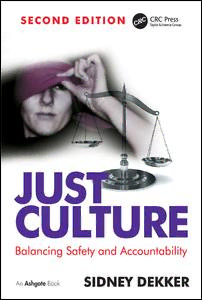Table Of ContentJUST CULTURE
To:
F.C.K., C.L., H.N., E.H. and P.N.
Just Culture
Balancing Safety and Accountability
2nd Edition
SIDNEY DEKKER
Griffith University, Australia
CRC Press
Taylor & Francis Group
6000 Broken Sound Parkway NW, Suite 300
Boca Raton, FL 33487-2742
© 2012 by Sidney Dekker
CRC Press is an imprint of Taylor & Francis Group, an Informa business
No claim to original U.S. Government works
Printed on acid-free paper
Version Date: 20160506
International Standard Book Number-13: 978-1-4094-4061-1 (Hardback)
This book contains information obtained from authentic and highly regarded sources. Reasonable
efforts have been made to publish reliable data and information, but the author and publisher can-
not assume responsibility for the validity of all materials or the consequences of their use. The
authors and publishers have attempted to trace the copyright holders of all material reproduced
in this publication and apologize to copyright holders if permission to publish in this form has not
been obtained. If any copyright material has not been acknowledged please write and let us know so
we may rectify in any future reprint.
Except as permitted under U.S. Copyright Law, no part of this book may be reprinted, reproduced,
transmitted, or utilized in any form by any electronic, mechanical, or other means, now known or
hereafter invented, including photocopying, microfilming, and recording, or in any information
storage or retrieval system, without written permission from the publishers.
For permission to photocopy or use material electronically from this work, please access www.copy-
right.com (http://www.copyright.com/) or contact the Copyright Clearance Center, Inc. (CCC),
222 Rosewood Drive, Danvers, MA 01923, 978-750-8400. CCC is a not-for-profit organization that
provides licenses and registration for a variety of users. For organizations that have been granted a
photocopy license by the CCC, a separate system of payment has been arranged.
Trademark Notice: Product or corporate names may be trademarks or registered trademarks, and
are used only for identification and explanation without intent to infringe.
Visit the Taylor & Francis Web site at
http://www.taylorandfrancis.com
and the CRC Press Web site at
http://www.crcpress.com
Contents
List of Figures and Tables vii
Preface ix
Prologue: A Nurse’s Error Became a Crime xv
1 What is the Right Thing to Do? 1
2 “You Have Nothing to Fear if You’ve Done Nothing Wrong” 15
3 Between Culpable and Blameless 25
4 Are All Mistakes Equal? 35
5 Report, Disclose, Protect, Learn 51
6 A Just Culture in Your Organization 73
7 The Criminalization of Human Error 87
8 Is Criminalization Bad For Safety? 103
9 Without Prosecutors, There Would Be No Crime 115
10 Three Questions For Your Just Culture 131
11 Why Do We Blame? 149
Epilogue 159
Index 165
9
Taylor & Francis
~
Taylor & Francis Group
http://taylora ndfra ncis.com
List of Figures and Tables
Figure
10.1 A staggered approach to building a just culture 141
Table
5.1 The difference between disclosure and reporting for
individuals and organizations 64
9
Taylor & Francis
~
Taylor & Francis Group
http://taylora ndfra ncis.com
Preface
Keith Ramstead was a British cardiothoracic surgeon who moved to New
Zealand. There, three patients died during or immediately after his operations,
and he was charged with manslaughter.1 Not long before, a professional
college had pointed to serious deficiencies in the surgeon’s work and found
that seven of his cases had been managed incompetently. The report found its
way to the police, who subsequently investigated the cases. This in turn led to
the criminal prosecution against Ramstead.
From Acts of God to Culpable Mismanagement of Risk
We have not always looked at three dead patients as evidence of a possible
crime, or as any form of reprehensible behavior. Turning to human error as
explanation for an accident, and making it into a culpable act or a crime,
is only a very recent way of dealing with failure. In fact, the whole idea of
an “accident” is relatively modern.2 Up until the scientific revolution in the
seventeenth century, we apparently had no need for a concept like “accident.”
Religion and superstition supplied ample explanatory models for things that
went wrong. We called it fate, predestination, God’s will, witchcraft, taboo-
breaking. Where misfortune was going to hit was—as far as mortal humans
were concerned—random, uncontrollable.
It stayed this way for the next couple of hundred years, though ever fewer
people bought into the idea that accidents had divine or demonic incitement
behind them. In the early twentieth century, we began to see accidents as
unfortunate but otherwise meaningless coincidences of space and time. As
random physical events, though, we still did not consider accidents worthy of
study. And we judged attempts to predict and prevent accidents as largely useless.
Over the last thirty years, however, this interpretation of accidents has
shifted dramatically. Startling failures such as the Three Mile Island nuclear
accident in 1973 and the collision of two jumbo jets at Tenerife in 1977 moved
accidents back onto the center stage of our societies.
No longer do we see accidents as meaningless, uncontrollable events. On
the contrary: Accidents are evidence that a particular risk was not managed
well enough. And behind that mismanagement, there was a person, or multiple
people. Today, even though we use the word quite freely, we have actually

